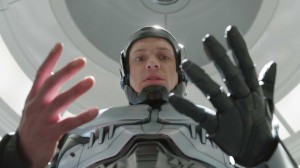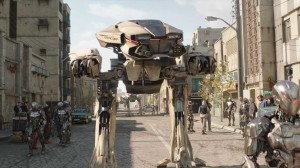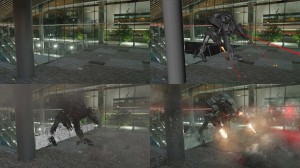
The company also gave a more formidable spin to the original ED-209s and created the new humanoid EM-208s, as well as creating huge battle sequences, extending sets, blowing up the car that injures good-cop Alex Murphy and building OmniCorp’s headquarters. Overall, the company worked on the project for just over a year.
“Having a reliable and creative VFX vendor is key for movies like Robocop,” said Padilha. “I was very lucky this way, as MGM introduced me to Framestore, one of the best things that happened to me on Robocop.”
 The film opens with a live broadcast from Tehran, showcasing the pacifying police role that OmniCorp’s range of robots carry out in the field. On set in Toronto there was a 300-foot section of the street, built to two stories high. Framestore was called on to top up the buildings and extend the set out into the distance, add smoke, explosions and general destruction and also to populate the sequence with fully CG ED-209s, the towering robots that will be familiar from the original film, and the humanoid EM-208s.
The film opens with a live broadcast from Tehran, showcasing the pacifying police role that OmniCorp’s range of robots carry out in the field. On set in Toronto there was a 300-foot section of the street, built to two stories high. Framestore was called on to top up the buildings and extend the set out into the distance, add smoke, explosions and general destruction and also to populate the sequence with fully CG ED-209s, the towering robots that will be familiar from the original film, and the humanoid EM-208s.
Framestore worked on several key sequences in Murphy’s transformation into RoboCop – creating the car explosion that injures him, exposing his brain during the subsequent surgery sequence and crafting the big reveal when Murphy learns the full extent of what has been done to him.
A big part of the work was augmenting the physical suit made by Legacy Effects to make it seem more robotic in ways that wouldn’t be possible without VFX. A section between the end of the shoulder and the beginning of the upper arm was gouged out and the abdomen was slimmed it down to make negative space in the hips and the pelvis. The company also took out areas around the elbows and his neck. “It was all to confuse the audience and make them wonder how they could have possibly got a man in that suit,” explained Duncan.
 The black RoboCop suit was done slightly differently. The shoulders were modified as before, but with the black suit’s slimmer look the abdomen only needed to be warped, rather than replaced. The stomach would be tracked to work out where it would be in the shot, then the compositors would take that geometry and use that as a basis to warp the plate to produce the desired silhouette.
The black RoboCop suit was done slightly differently. The shoulders were modified as before, but with the black suit’s slimmer look the abdomen only needed to be warped, rather than replaced. The stomach would be tracked to work out where it would be in the shot, then the compositors would take that geometry and use that as a basis to warp the plate to produce the desired silhouette.
For some sequences and particularly stunt-work, a full-CG RoboCop was needed, which meant the real thing had to be matched completely photo-realistically. In other scenes a partial suit was used to allow greater movement for the stunt actors and then completed in CG.
The film’s destructive final battle between RoboCop and multiple CG ED-209s in an environment that was unsuitable for large scale practical effects (actually the Vancouver Conference Centre), is a medley of thousands of bullets, millions of shards of glass and plenty of explosions. “It’s a bit like the Tehran sequence. We pretty much touched every shot,” said Duncan. “If there’s an explosion you have to keep the residue rolling over into the next few shots.”
“On set they weren’t allowed to set off many practical effects, although a fake column was brought in and blown up, so we basically had to destroy the whole of the Vancouver Conference Centre digitally. We needed a lot of imagination to reach what you see in the final sequences,” Duncan added.
The destruction is so intense that it required the development of a completely new in-house bullet system to handle it. “We needed it because there was going to be so much gunfire and you needed to work out the effects of each bullet. I suppose you could animate each one and work out where it hit then apply a reaction to that, but that would have been so labor intensive that we would still be doing it now!”
As the battle goes, on the ED-209s literally bring out the big guns. The company wanted to give them a signature look to make sure the audience would appreciate the increase in firepower. The inspiration for it came from a strange source however. “I happened to be watching Richard Hammond Builds a Planet on BBC2,” said Duncan, “and they showed what happens when you fire a high calibre machine gun at a steel plate. It super heats and in slow motion you see these little licks of flame which you wouldn’t really notice when you’re viewing in real time. So that became the reference point to distinguish it from normal impacts and the ‘Richard Hammond effect’ became the short-hand for describing when we should see that type of impact and everyone found it hilarious.”
“Overall it was a very smooth show,” said Duncan. “The Arnold pipeline was a big part of that, meaning the lighting wasn’t an issue at all, and our adoption of Shot Review Plus meant working across two sites, and with a new team in Montreal, went really well. It didn’t matter where the work was done. The quality was superb.”





